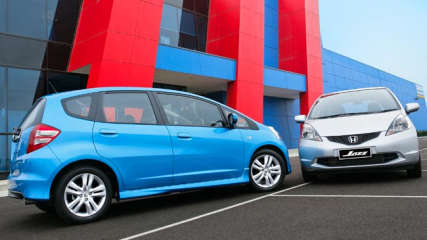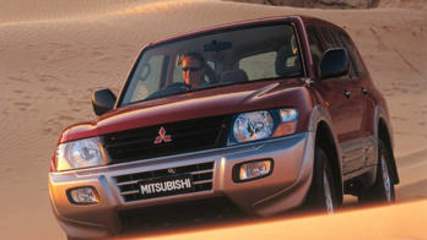Honda Jazz 2003 News

Honda races to fix Takata airbag faults
Read the article
By Laura Berry · 06 Dec 2016
Honda Australia is working around the clock to replace 600,000 potentially faulty airbags.

Deadly Takata airbag recall nears 1.2 million in Australia
Read the article
By Joshua Dowling · 17 May 2016
Only a fraction of the 1.2 million cars on Australia roads with airbags that can spray shrapnel have been fixed, new figures show.

Honda Jazz supercharged for China
Read the article
By Neil Dowling · 19 Jul 2010
In its new-found freedom, the country is also discovering customising and, with it, performance enhancements. In a two-pronged approach to China's exploding car sales, Perth-based Sprintex Superchargers has completed five trial Honda Jazz models that it hopes will lead to a lucrative business.
The cars have been supplied to the China-based Honda joint-venture manufacturer of the Jazz and are intended as precursors to either OEM (original equipment manufacturer) or after-market kits. Sprintex business development manager Jay Upton says the supercharger boosts performance of the 1.5-litre Jazz engine but - more importantly - will deliver reduced emissions for a similar performance of bigger engines.
He says the Jazz superchargers will initially be for export mainly to China, however the system will be offered in US and in Australia. No price has been fixed but expect about $3500. "Whilst we did not really expect the local market to be excited by a hotter version of a Honda Jazz, we have been a little surprised by the interest from our home market," he says. "It's not the car that I would pick to hide a supercharger."
Mr Upton says China is an attractive sale proposition. "The China market produces more than 70,000 Fits (Jazz) a year and our partners there are projecting annual sales of more than 1000 systems for the car in China alone," he says.
"We are expecting China to become our largest market and small cars to be the majority of that market. More than 70 per cent of cars produced in China are 1.5 litre or less, hence the market for performance aids for smaller engines.
The move to superchargers also follows similar product development in forced-induction and downsizing engines. China's biggest car maker, Geely, has three small-bore engines in 1.3 and 1.5-litre guises that go on sale in China next year with Eaton superchargers.
Nissan will have a new Micra in Europe with an optional 1.2-litre three-cylinder supercharged engine that claims 40 per cent more power and about 20 per cent lower emissions than its 1.4-litre normally-aspirated sister.
Mr Upton says the Honda Jazz trial unit in Australia - the other mules are in Asia - is a current model 1.5-litre V-Tec VTi model. "The car uses the smallest current Sprintex unit, the S5-150, to increase power by about 40 per cent to 100kW, up from the standard 72kW," he says.
"These are our measured figures, on our dyno, not Honda's stated outcome." The alloy-bodied supercharger is the same base unit that is available as an aftermarket product for the Harley-Davidson Evo models and the Ducati Hypermotard.
"In fact, the 150 - the figure means 150 litres a second of air produced - suits engines from 800cc to about 1800cc," says Mr Upton. "The biggest we make suits engines up to about 4.5 litres, such as the bigger 4WDs. We have kits for those and are making additional kits for the new 4-litre V6 Toyota engine that's fitted to the Prado and Hilux.
"We have a strong business supplying aftermarket kits to 4WDs and we see the move towards the smaller engines, such as the Jazz, as being our future. We have no intention of making units for the 5-litre or 6-litre muscle-car engines.
"Our focus is on designing superchargers to make small engines maximise performance while minimising emissions and fuel use." Sprintex also has supercharger kits for the Mitsubishi Magna/380 which are sold through Mitsubishi's TMR division.

Cars play name game
Read the article
By Paul Gover · 27 May 2010
A Mustang is a wild brumby in the USA but also one of the all-time best muscle cars; the LandCruiser does just what the name says, even if the land is the worst of the Australian outback; and the Enzo is a tribute to the man who founded the world's best-know supercar company, Ferrari.But the name game can go badly wrong. The Nissan Cedric was never going to be a hit in Australia with a name that creates a picture of an aging uncle Arthur in a cardigan, Taurus is tough in the USA but was always going to flop against the Falcon, and the Skoda Roomster has just been dumped after failing to find a home down under.Holden was careful to avoid the VD in its Commodore line, but why did it start with the VB and not the VA? And what about the Statesman, which went well as the WB but was never updated into the WC? Just this week I was following a Citroen Jumpy delivery fan in Portugal, and wondering if the name was a reflection of the driver's behaviour or the way it runs on the road.The craziness goes on and on, like the Citroen Picasso people mover which is anything but an oil painting. Today's showrooms also have cars whose names have more numbers and letters than a cryptic crossword, with just as much meaning. Who really knows the difference between an A7 and a C350?But head back in history and there are some absolute clangers. Henry Ford named the 1950s Edsel after his son, but is now recorded as one of the biggest flops in blue-oval history. Japan has given us everything from the Daihatsu Rocky and Rugger to the Honda Ascot and Acty Crawler and on through the Isuzu Big Horn to the Subaru Justy.Nissan created the Tiida name from nothing, even though it claims it has something to do with waves breaking on a beach, and Lexus is even a made-up brand name, in contrast to Mercedes which was named after an early Daimler customer's daughter. Over in America, the AMC Gremlin was a flop, the Dodge Neon never went up in lights, Plymouth Reliant never lived up to its promise, and the Lincoln Town Car was so big it needed its own postcode.Even some of the names which have worked create more questions than answers about their creation. The Kia Mentor is more likely to need one, the Honda Jazz is not much of a music machine and the Suzuki Cappucino was too frothy to sell in Australia.Some names also paint a picture because of their history. Mention Celica and lots of people in Australia think hairdresser. Ask about the Nissan GT-R and you'll hear about Godzilla.Camry is shorthand for fridge-on-wheels, Kingswood is classic sixties kitsch, and then there is the Goggomobil. So, what's causing a Rukus today? The Toyota Rukus, for a start.We could also get the Nissan Cube, which is as boxy as its name, although Nissan Australia is also pushing for a return of the Pulsar badge which worked so well before the silly switch to Tiida. Right now we have the Skoda Superb in Australian showrooms. If that's not a name which creates a serious expectation then we don't know our Falcodores.When Toyota was looking for a new name for a mid-sized car alongside the Camry it thought it had the ideal choice. It settled on Centaur - the mythical man-horse - because it sounded tough. But no-one at Toyota Australia had taken into account a nasty incident in World War II during the battle for the Pacific.A hospital ship called the Centaur was sailing towards Brisbane when it was torpedoed and sunk by a Japanese submarine. The idea of a Toyota Centaur sunk even faster. The Centaur badges were crushed, all the paperwork was changed and so was the advertising. The Centaur quickly became the Avalon for Australia. How do we know? Carsguide made the call to Toyota to warn about the problem. Japanese cars have always led the way in the silly-names race. How about the Mazda Bongy Brawny? No, not the name for an off-road tough SUV, it was the badge on the back of a city delivery van with a 1.3-litre engine.Everyone has heard the story about the Mitsubishi Starion, and whether the company's sales team actually meant to call the turbo coupe the Stallion. And then there is the Pajero. It's called the Montero in Spain, because Pajero is the word for something usually done alone in private.

Recall flurry
Read the article
By CarsGuide team · 10 Nov 2008
In extreme situations, owners have been warned their vehicles may catch fire.Mitsubishi was hit with the biggest safety recall for the three month period. It has written to owners of Pajeros built between 2000 and 2003 to warn them of a potential brake problem. As many as 13,400 vehicles may need to be checked.The company also recalled 4400 of its now-defunct 380 sedan, built between 2006 and 2007, which may have a faulty fuel tank retaining strap. In a severe collision the tank may be dislodged and spill fuel.Mitsubishi is also checking more than 8300 Colts built this year which may have a problem with door windows which may drop and unlock or open the door while the car is being driven.Honda has recalled 11,800 of its 2004-05 Jazz to check whether they have a faulty handbrake, while Mazda needs to look at 1770 of its B4000 utes built between 2005-2006 because the bonnet may open unexpectedly.Subaru has recalled 5380 of its Imprezas, built between 2001 and 2003 because of a faulty rear tailgate which may suddenly drop.Subaru Australia spokesman, Dave Rowley, said many of the recalls were to check for "minor or niggling" faults."We have had no incidents of anyone being injured in Australia and we found only six cars which had the faulty (tailgate strut) connection."Many recalls are done as a pre-emptive measure to avoid possible problems further down the track, " he said.Other potential faults include electrical short circuits, which in extreme circumstances, may start a cabin fire in Landrover Freelander diesels built since 2007. Landrover warns the fault may occur when the vehicle is parked and unattended.Other recalls were to check for short circuits in Fiat's Grande Punto; and a chance that the panoramic glass roof in a small number of Citroen's Picasso could be dislodged.Suzuki has warned of potential fire risk in its 3-door Suzuki Grand Vitara (2006-07) because of a possible cracked fuel pipe, while the 2005-08 Vitara diesel has a remote fire risk in a filter because of a problem with the intercooler outlet pipe insulator.Other problems include faulty rear seat belt D-loop attachments in the current Jaguar XF, and the potential for a loss of steering in Chrysler's 300C built last year because of a problem with rear axle hub nuts which could see the half shaft disengage from the wheel hub.Mercedes Benz wants to look at axles, springs and the park brake in its Sprinter or Vito vans.Jayco has recalled some of its motor homes to check and fix awning and exhaust pipe problems.Of the 1500 motorcycles recalled, safety issues to be fixed include a faulty fuel filler on Kawasaki models, a windshield which may come off Buell bikes if ridden at high speed and a rear view mirror which may fall off on certain Yamaha models.An ACCC spokeswoman said this year's figures were actually less than last year but the number has been steadily rising over the past 20 years.The ACCC says there have been 52 individual recalls this year compared to 171 last year.Full details of the recalls can be found at www.recalls.gov.au




